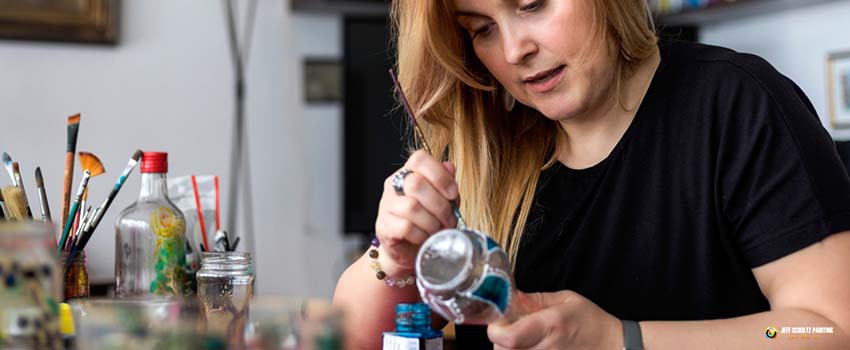Have you considered the possibility of painting the glass surfaces in your home, but you are uncertain whether this home improvement job can be done by yourself? Or have you been thinking of some glass painting art projects to help you bond with your kids?
When selecting whether you should paint glass surfaces in and around your home, it is crucial to keep in mind that this is a task you can accomplish if the appropriate supplies are used and a small amount of time is spent learning how to paint glass.
This step-by-step guide will teach you how to prepare paint easily and protect your glass home surfaces. Moreover, this article will also delve into the best methods and products to accomplish these projects.
What Type of Paint is Best to Use on Glass
Enamel Glass Paint
Enamel paints adhere to smooth or shiny surfaces like metal, ceramic, and glass. Select opaque or transparent enamels; translucent enamels give the impression that the piece is solid-colored glass, but they will change color when you add various colored liquids or objects.
Acrylic Glass Paint
Acrylic paints designed for crystal, plastic, and glass painting are typically transparent and intended to resemble stained glass. Acrylics, like enamels, can be applied with a soft and flexible brush or a sponge. Some brands require oven curing for increased durability.
Oil Glass Paint
Oil or solvent-based paints are not as popular for glass as other forms of paint, but you may prefer them if you enjoy working with oils. The hues are either transparent or opaque and may have a brilliant sheen. Since oils do not readily dissolve in water, the finished product can be washed by hand.
Glass Paint Markers
Glass paint markers facilitate application because they allow for precise drawing and writing, which is difficult with a brush. Some brands require heat curing and can only be blended with paints that also require heat curing.
Glass Painting Step-by-Step Guide
Step 1: Inspect your glass surface.
When painting glass, the first step is to inspect the glass surface for any cracks, missing glass pieces, defects, and so on. You must inspect the surface of the glass to confirm that the surface is in suitable condition for painting. Next, you must practice your preparation to ensure that the paint adheres well to the surface.
Step 2: Prepare the tools and equipment.
Always put safety first when working on DIY projects. It is best to be safe while learning how to paint glass, which is why it’s recommended to use goggles, gloves, and a mask when you’re painting. In addition, you should prepare all the tools and materials needed in glass painting for more convenience. Here’s the list of items you need for a glass painting project:
- Cloth rags/ Paper towels
- Alcohol
- White vinegar
- Dishwashing detergent
- Oil
- Water container
- Paint tray
- Soft bristle paint brush
- Your choice of glass paint
- Drop cloth
- Painter’s tape
- Dabber
- Stencils
Step 3: Prepare your glass for painting.
When learning how to paint glass permanently, the ideal place to begin is by properly prepping the glass surface. To accomplish this, use a towel, rag, warm water, and soap to clean the surface. The surface should then be allowed to dry completely.
The final step is to polish the glass surface. Wet a paper towel or cloth rag with a mixture of rubbing alcohol and white vinegar, then add a little amount of dish detergent and warm water. This will help remove any leftover fingerprints or soap film.
Step 4: Choose appropriate brushes and glass paint.
You will want to use a soft-bristled brush for this specific project. When painting a glass surface, employing “soft bristles” will reduce the number of apparent brush strokes as much as possible. A softer brush will always yield the smoothest application results when painting glass.
Next, you will need to select paints developed specifically for glass surfaces. Selecting the appropriate type of paint is crucial to getting the desired results.
Step 5: Apply paint to the glass surface.
Regardless of your chosen method, always remember to cover and tape off the parts you do not wish to paint to prevent paint splatters around your project areas.
To begin, apply primer to any glass areas with darker surfaces. However, you can also paint directly on the glass surface; just ensure you let your paint dry completely. After your first layer has dried, apply a second and final coat.
Step 6: Application of a waterproof coating.
Sealants and waxes are always recommended to extend a painting project’s life. In addition, employing topcoats and sealants will help your painted surface to be waterproof.
Step 7: Allow the paint to dry.
You are nearly finished learning how to paint glass and practicing your newfound knowledge. The only remaining step is to allow the paint to dry. For optimal results, allow the painted area to cure for 36 to 48 hours. Always refer to the paint’s instructions on the back of the can.
Types of Glass Painting Ideas
Now that you’ve mastered the basics of glass painting, you can tackle other painting projects at home. Here are some glass painting ideas to inspire you:
- Creating artwork on wine bottles.
- Incorporate painted designs on wine glasses.
- Paint art on window panels.
- Create an artsy design on glass jars.
- Refurbish glass vases through painting.
Frequently Asked Questions About Glass Painting
Can you paint glass?
Yes, you can. Simply use acrylic-enamel paints or enamel specially formulated for glass and tile.
How Do You Keep Paint on Glass?
Knowing how to seal paint on the glass is vital as using the appropriate tools. Choose a gloss finish rather than a matte finish for a more polished appearance. If you want your paint to last long, use permanent paint or seal your finished work.
Will Acrylic Paint Strip away From Glass?
Yes. Soften the paint with a rag dipped in warm water, then carefully scrape it away with an old credit card or putty knife.
Conclusion
Glass painting is a fantastic skill to acquire, regardless of whether you’re trying to create DIY home décor, want something enjoyable to do with your kids, or wish to broaden your artistic ability. You should have no problem mastering the craft of glass painting with a little instruction and practice. With the step-by-step guide and tips listed above, you’ll find glass painting a specific skill you can learn in no time.
Spruce Up Your Home Creatively With Jeff Schultz Painting.
Learning a new skill and putting it into practice is a notable achievement. Glass painting is an easy and simple skill to learn with the proper guidance and fundamental knowledge. However, if your time doesn’t permit elaborate labor but you want to spruce up your home, you can always engage the services of Jeff Schultz painting, the top painters in Sarasota, to do the job for you. You’ll be assured of utmost professionalism and satisfaction with their years of expertise. Call us now for an estimate.









